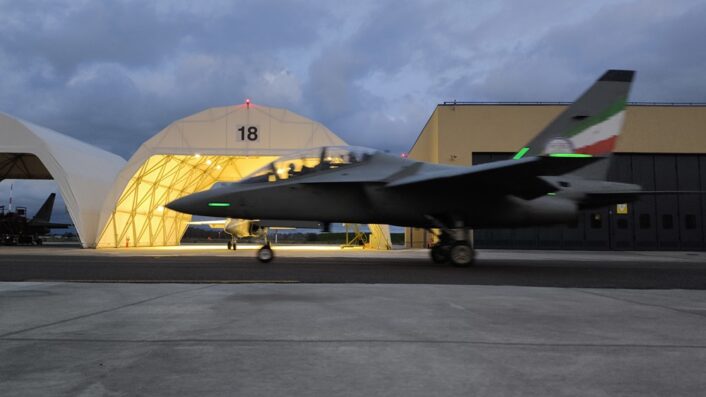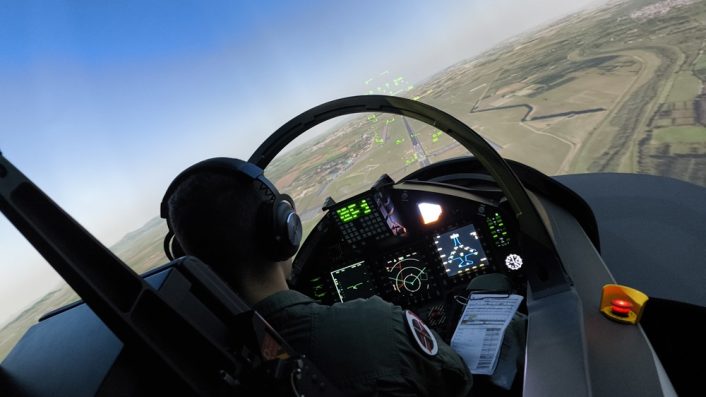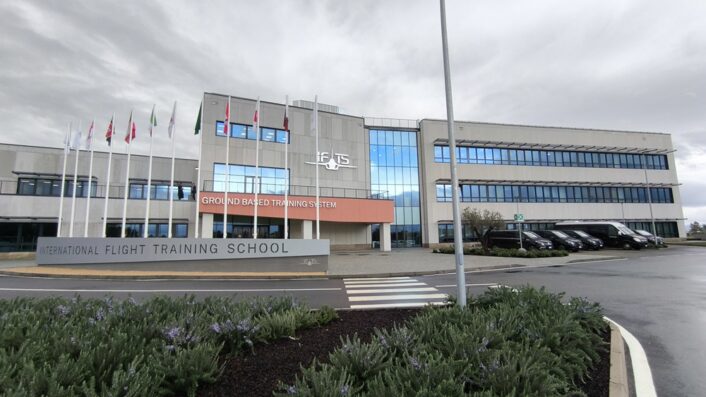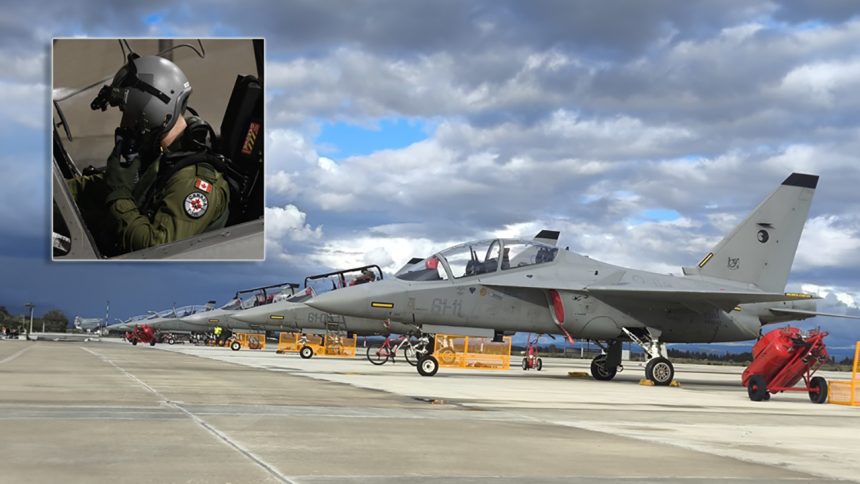Pilots from the Royal Air Force and Royal Canadian Air Force have completed the LIFT (Lead In to Fighter Training) course at the International Flight Training School (IFTS) in Decimomannu, Italy.
The first cadre of RAF and RCAF pilots trained in Italy at the International Flight Training School at Decimomannu air base have completed the LIFT course, the most advanced phase of the pilot training, that the Italian Air Force/Leonardo IFTS provides using the T-346A advanced training aircraft and its integrated training system at the campus built in Decimomannu Airbase (or “Deci”), in Sardinia, Italy.
Started in July 2023 the LIFT course was completed one month ahead of schedule. During the training students conducted real and synthetic training missions, training under the widely adopted “train as you fight” concept, to better prepare them for operational units. Today’s fighter pilots need to have first order management skills as right now the superiority against adversaries is obtained in the information domain, the fusion of the info from multiple domains and the reaction time. The modern LIFT training highly reflects these needs.

The T-346 can provide adequate training for 5th generation aircraft with most equipment that can be found on modern frontline fighter aircraft such as Voice Control Inputs (VCI), Helmet Mounted Display (HMD), and even an NVG module for the HMD allowing for night operations training.
The syllabus developed for the Phase 4 heavily exploits the ground training segment of the M-346 to build these capabilities, with the live flights being the last step of the training and amounting to roughly 50% of the training events. The simulator training is so realistic that can be counted as real flight hours, without losing training effectiveness.

Many air forces have elected the IFTS and its training paradigm for the Phase IV training of their pilots:
- Italian Air Force
- Republic of Singapore Air Force
- Royal Qatari Air Force
- Royal Canadian Air Force
- Royal Air Force
- German Air Force
- Japan Self-Defence Force
- Austrian Air Force
- Royal Saudi Air Force
- Swedish Air Force
At the moment, the school is hosting attendees from Austria, Canada, Japan, Qatar, Saudi Arabia, Singapore and the UK.
“The International Flight Training School (IFTS) is an Italian excellence of international value, which brings together the consolidated know-how of the Air Force in the flight training and the excellence of an Italian industry such as Leonardo in the field of integrated systems for the training of military pilots”, Col. Vito Conserva , Commander of the 61° Stormo of the Italian Air Force, said in a public statement. “IFTS represents a reference for the advanced training of military pilots from air forces around the world who fly on technologically advanced fighters, such as the Eurofighter or F-35 aircraft and is a virtuous example of national institutional and industrial synergy capable to satisfy the growing demand of the Air Force and partner countries for pilot training”.

Royal Air Force
Dealing with the Royal Air Force, the service joined IFTS on May 13, 2023, with an agreement signed during the AeroSpace Power Conference held in Rome. A total of 12 RAF pilots are expected to train over a three-year period in Italy.
“Deci at the moment is getting the pilots ready for the GCAP or Eurofighter”, said Air Chief Marshal Sir Mike Wigston at the signing ceremony, “but what’s exciting to me about Deci is the principles which have been applied, and it is a glimpse of the future, in terms of AR (Augmented Reality), Synthetic Training, platforms being used. And it might not be Deci, might not be the systems and aircraft there, but the principles that the Italian Air Force, Leonardo and CAE: that points to how we will internationally do pilot training in the future.”
The training at the IFTS allows the RAF to mitigate the issue of the poor Hawk T2 engine availability that has caused a lot of criticism lately: in fact, as reported by The Times, problems with the Hawk T2 trainers have resulted in less than half the fleet being available for training in the UK because they cannot fly for too long without engine issues (or “blowing up” as some sources said).
“Although there are 28 Hawk T2 jets in the fleet, of which about 20 were planned to be available daily, only about eight were available each day throughout 2022-23,” the newspaper reported, highlighting how the RAF advanced trainer aircraft could only fly for 1,700 hours, instead of the expected 4,000 hours, with a significant impact on the ability of the RAF training system to move pilots along the training pipeline.
Royal Canadian Air Force
We had also the opportunity to interview Brig. Gen. Todd N. Balfe, Royal Canadian Air Force (RCAF) Fighter Capability Special Advisor at the inauguration of the IFTS campus in Decimomannu last year. The RCAF has recently retired its CT-155 ending the insourced advanced training of its combat pilots.
Here’s what he told us about the RCAF expectations.
“The RCAF is excited to be here, we have been planning to join the program for some years”, told us Brig. Gen. Todd N. Balfe, Royal Canadian Air Force (RCAF) Fighter Capability Special Advisor. “We now have an Instructor Pilot who’s been assigned to the IFTS, he’s already begun flying and he’s the first of many Canadians who will be trained here over many, many years. Part of the reasons is necessity, as we are transitioning out of our old training system, we are going to be build a new training system, but we have a gap of 8 to 10 years, where we don’t have our system back in Canada. As we looked around the world, it was quickly apparent to us that IFTS is a world leading training system so we wanted to be here to produce some of the best fighter pilots we could, but also to learn from the system. So as we spend time here with our IPs and student pilots, we will take all the lessons back to Canada where we’ll build our own system. And I will conclude by saying that Gen. Luca Goretti, the Commander of the Italian Air Force, is right: IFTS is the only 5th generation training system in the world.”
“I got a chance to fly in the M-346 and now that I’ve flown in the aircraft with the Squadron Commander I must say that I was really impressed. Same for our IP, who’s a former F-18 pilot (as I used to be an F-18 pilot): he’s flown the aircraft and carried out various missions in the simulator and he also remarked how similar the M-346 is to the F-18 in terms of flying characteristics: it’s not as fast because it doesn’t have the afterburner, but the rest of the airplane characteristics are remarkably similar as are information displays. He’s impressed with the aircraft, he’s very impressed with the system and training, the simulator and all of the LVC capabilities are truly impressive, in my travels I’ve not seen a system like this in the world, and I think the world is gonna build more systems like this one, because it allows us to train our pilots faster, better and ultimately cheaper.”
There will be two instructors and six Canadian students at the IFTS in Italy by 2025.









